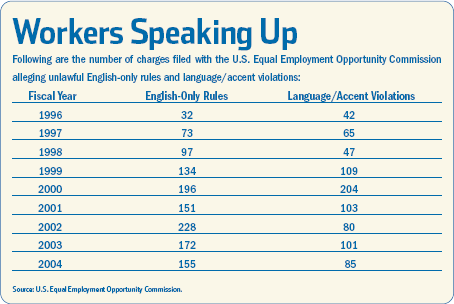 Agenda: Multilingual WorkforcesHow can employers help employees who speak different languages work in harmony?
Agenda: Multilingual WorkforcesHow can employers help employees who speak different languages work in harmony?
When David Hodges launched a gourmet food business in 2002, his first apprentice was a newly arrived Mexican immigrant with a solid work ethic but shaky English.
“I met Javier while volunteering, teaching English in a local literacy program,” says Hodges, owner of Palazzo Foods, a producer of specialty bread products in Collingswood, N.J. “He spoke limited English, but honestly, my Spanish was a whole lot worse.”
At first the two struggled to communicate at work—verbally stumped when it came to discussing recipes, packaging and other production matters. “We didn’t have a common language,” notes Hodges. “So there was a lot of hand gesturing, with me demonstrating what I needed him to do.”
Slowly but surely, each began to understand the other. “I helped Javier with his English, and he taught me more Spanish,” says Hodges. “We learned from each other.”
Today, Palazzo Foods’ small staff includes several workers of Hispanic descent. Inside its commercial kitchen are simple instructions posted in both English and Spanish; an online translation service helps Hodges with more-difficult phrases.
Hodges, who continues to teach English to his staff and is improving his Spanish, says: “I have found out how innovative new immigrants can be. Despite the language challenges, it’s been a positive experience.”
Hodges’ approach is a small but telling example of how employers can adopt simple techniques to help employees learn to work effectively, even if their primary language is not English. Finding ways to keep language differences from becoming obstacles to success—for employers and employees alike—will be a workplace challenge that more and more companies will have to address in an increasingly multilingual economy.
A Variety of Voices
As the United States experiences a burgeoning wave of immigration from Latin America, Asia, Eastern Europe, sub-Saharan Africa, the Caribbean and other regions, the nation’s workforce is becoming not only more diverse but also increasingly multilingual.
By 2008, according to the U.S. Bureau of Labor Statistics (BLS), 41 percent of the nation’s 39 million workers will be members of minority groups; Hispanics make up the country’s fastest-growing minority. By 2050, minorities are expected to rise from one-fourth to one-half of the U.S. population.
In the 2000 census, nearly 47 million people—about one in five U.S. residents—reported speaking a foreign language regularly at home, an increase from 15 million people in the 1990 census.
“Language is becoming such an important issue in the workplace,” says Sandra Slipp, a diversity consultant with Organization Planning and Training Associates in Englewood, N.J. She and co-principal Renee Blank, authors of best sellers on workplace diversity, worked with employees at clients ranging from major financial and pharmaceutical companies to the Internal Revenue Service, and their findings indicate the scope of the challenge for employers.
Some Asian Americans, for example, have told Slipp and Blank that other Americans interrupt them, even finishing sentences for them. Latinos reported being criticized by managers and co-workers for speaking Spanish to Latino colleagues. Many immigrants have said they’re treated as if they’re unintelligent or inferior because of the way they speak English, while others have said co-workers and employers assume they don’t want to learn English.
“Limited proficiency in English is also a key workforce issue, as are differences in verbal and nonverbal communication styles,” notes Slipp. “While it’s essential that people speak [at work] in ways that clarify issues like safety, it’s also important to remember that language has emotional resonance.”
Slipp explains that by speaking with one another in their shared native tongue at work, workers may be relieving anxieties of the job. “It’s usually not to exclude others, but to feel more comfortable,” she says. “But many Americans will think, ‘I don’t know what you’re saying. Oh, they’re talking about me. I feel left out.’ ”
No Room For Misunderstanding
In some workplaces, such as hospitals and construction sites, what’s said—or not said—can have life-or-death importance.
It’s a crucial issue at the prestigious Johns Hopkins Medical Institutions in Baltimore, where the patients, medical professionals and support staff hail from all over the world. Bonnie Windsor, an HR consultant in the Labor Relations Department, says there are no formal language policies in place, but “diversity training is done in every new-hire orientation, all management training classes and whenever necessary on units.”
Hopkins uses tools such as the Myers-Briggs personality indicators and “The Peacock in the Land of Penguins,” a diversity training series, to help people understand themselves and their behaviors.
“This is helpful in a multicultural environment because it connects people with similar preference styles and it gives them a common base from which to start communicating, focusing on the similarities rather than the differences,” explains Hopkins HR consultant Doris West-Walkin. She adds that to encourage and promote better communication among workers who may speak different languages, Hopkins is “very flexible in its approach.
“There has to be a strategy to create a mutual environment of awareness, appreciation and inclusiveness from both perspectives,” she says. “We assess and identify specific group issues and develop customized interventions and training to address the concerns by connecting the appropriate resources.”
Risks in a Hard Hat World
It’s estimated that nearly two-thirds of U.S. construction workers do not speak English as their primary language, potentially compromising safety in often-dangerous situations.
According to the federal Bureau of Labor Statistics, about 800 Hispanic workers lost their lives in job-related injuries in 2003; nearly 270 of those deaths occurred in the construction industry.
In July 2004, U.S. Secretary of Labor Elaine Chao convened the first Hispanic Safety and Health Summit in Orlando, Fla., bringing together more than 500 representatives of government, industry, labor, nonprofit and faith-based groups.
“Most of my workers are of Hispanic descent, but even if we’re speaking Spanish, safety is a big issue,” says Guillermo Salas Jr., a Puerto Rican developer in Philadelphia and president/co-founder of the Hispanic Association of Contractors & Enterprises. He and other industry experts say it is imperative that companies devise solutions such as bilingual policy manuals, instructions, signage and warning notices.
Employee training for both English and non-English speakers is also key, says veteran HR expert Vincent Ford, a former human resource manager for major corporations such as Western Union and Xerox. “The workplace is becoming much more global,” says Ford, now a consultant who heads VISTAR Corp. in East Stroudsburg, Pa., with clients that include AT&T, Lucent Technologies and Lockheed Martin. “When it comes to safety, some companies have operations manuals in different languages—I’ve seen Chinese, Spanish, Japanese and German.”
The federal government has also developed various language-related safety initiatives. For example, the Occupational Safety and Health Administration has a bilingual web site geared toward helping employees access safety compliance resources that have been translated into Spanish.
English-Only Resistance
Although many employers applaud moves to accommodate bilingualism on the job, it’s not uncommon for some to resist what they see as the demise of English in the U.S. workplace.
The U.S. Equal Employment Opportunity Commission handles complaints filed by immigrants questioning supervisors who require them to speak only English. (See “Workers Speaking Up”.) Although requiring English is allowed in instances of business necessity, it can be illegal if the requirement is misapplied, such as prohibiting the use of a foreign language during work breaks.
Under Title VII of the Civil Rights Act of 1964, all U.S. workers regardless of citizenship status are protected from employment discrimination based on factors such as race, color, sex and national origin. But the same law also preserves an employer’s freedom of choice to make sound business decisions.
To that end, some employers mandate English fluency as a so-called BFOQ—bona fide occupational qualification—particularly for highly skilled positions, notes Ford. “As one moves up the corporate ladder and reaches a certain level, there’s a definite expectation that you will speak English,” he says.
Slipp advises employers to “make the rules clear” about what languages are to be spoken at work. For instance, at Hopkins, in units where multiple employees speak English as a second language, they’re asked to speak English during work time, with the option of speaking their native tongue during breaks and meals.
Doing Whatever It Takes
Whatever the job requires, Ford says “forward-thinking companies” provide the tools for employees to succeed. That might mean encouraging workers to study English through ESL (or English as a second language) classes in the community, or sponsoring in-house classes, as companies such as condiment giant H.J. Heinz have done.
Ford also recommends that a new hire unfamiliar with English be paired with a mentor who speaks the person’s primary language. “A mentor helps them understand the rules of the road.”
One of the successes at Hopkins in lowering workplace language barriers has been the hospital’s work with the Maryland chapter of the Philippine Nursing Association. Hopkins, like many hospitals, is recruiting nurses from abroad, including from the Philippines. Many foreign-born nurses have excellent professional skills, but language barriers have sometimes caused problems.
“Although English is [their] primary language, there are different dialects and meanings of words,” says West-Walkin. “Even in our health care environment we mix the figurative and literal meanings of our words. We emphasize the shortcuts we often take when we communicate—for example, giving a nurse instructions to ‘Hit the call button,’ when what we really mean is, ‘Answer the call button now!’ ”
Such experiences ring true for Mary Dedeen Andrada, RN, a clinical transplant nurse coordinator from the Philippines who has a bachelor’s degree in nursing and was recruited by Hopkins six years ago. “Sometimes my [colleagues] may have a way of saying things differently, and I have to think about what they really mean,” says Andrada. “Or my accent may be different.”
Like others at the hospital, Andrada has benefited from older, more experienced Filipino mentors that Hopkins has put in place. She also has received many commendations for her work, and emphasizes that foreign-born nurses generally must take English proficiency tests before they can even sit for exams and practice in the United States.
Some hospitals and other organizations also use interpreters (different from translators, which are sometimes required by the federal government) to ensure that everyone has accurately interpreted what is being communicated. Such innovations embody the concept of “mutual accommodation,” as Slipp describes it.
Ford says it’s also increasingly essential to business success. “I think corporate America has grown up. We’re seeing an influx of talented people with skills. It’s amazing how much we can accommodate in the name of business and making money.”
Donna M. Owens is a freelance writer in Baltimore.
Web Extras
- Employers Seek Out High-Tech Options for Teaching Workers English (Source: HR Technology Forum)
- HR Magazine: English Classes Enable Top-Notch Service (July 2003)
- Language Issues (Source: EEOC Compliance Manual)
- Hispanic Association of Contractors & Enterprises
Advertisement
An organization run by AI is not a futuristic concept. Such technology is already a part of many workplaces and will continue to shape the labor market and HR. Here's how employers and employees can successfully manage generative AI and other AI-powered systems.
Advertisement



